Global Human Resource Management: Disney Reward Program Analysis
VerifiedAdded on 2022/08/29
|8
|2002
|21
Report
AI Summary
This report provides a detailed analysis of the employee reward programs implemented by the Disney Corporation, drawing on a group presentation and individual contributions. The report begins with an introduction outlining the aims of the report and a brief overview of the group presentation. It then delves into the core content, examining Disney's reward practices, including financial compensation (weekly pay, bonuses), non-financial benefits (career development, community involvement, commuter assistance, exclusive discounts), and fringe benefits (health insurance, childcare options, paid time off). The analysis incorporates theoretical frameworks and real-world examples to illustrate the application of these practices. The report then includes a reflection on the group presentation, highlighting areas of success and areas for improvement, and the individual's contribution. It also includes an action plan for future presentations and group work. The report concludes by summarizing the findings and emphasizing the importance of a comprehensive reward system in attracting, motivating, and retaining employees. The report also references various academic sources to support the analysis of Disney's reward program.
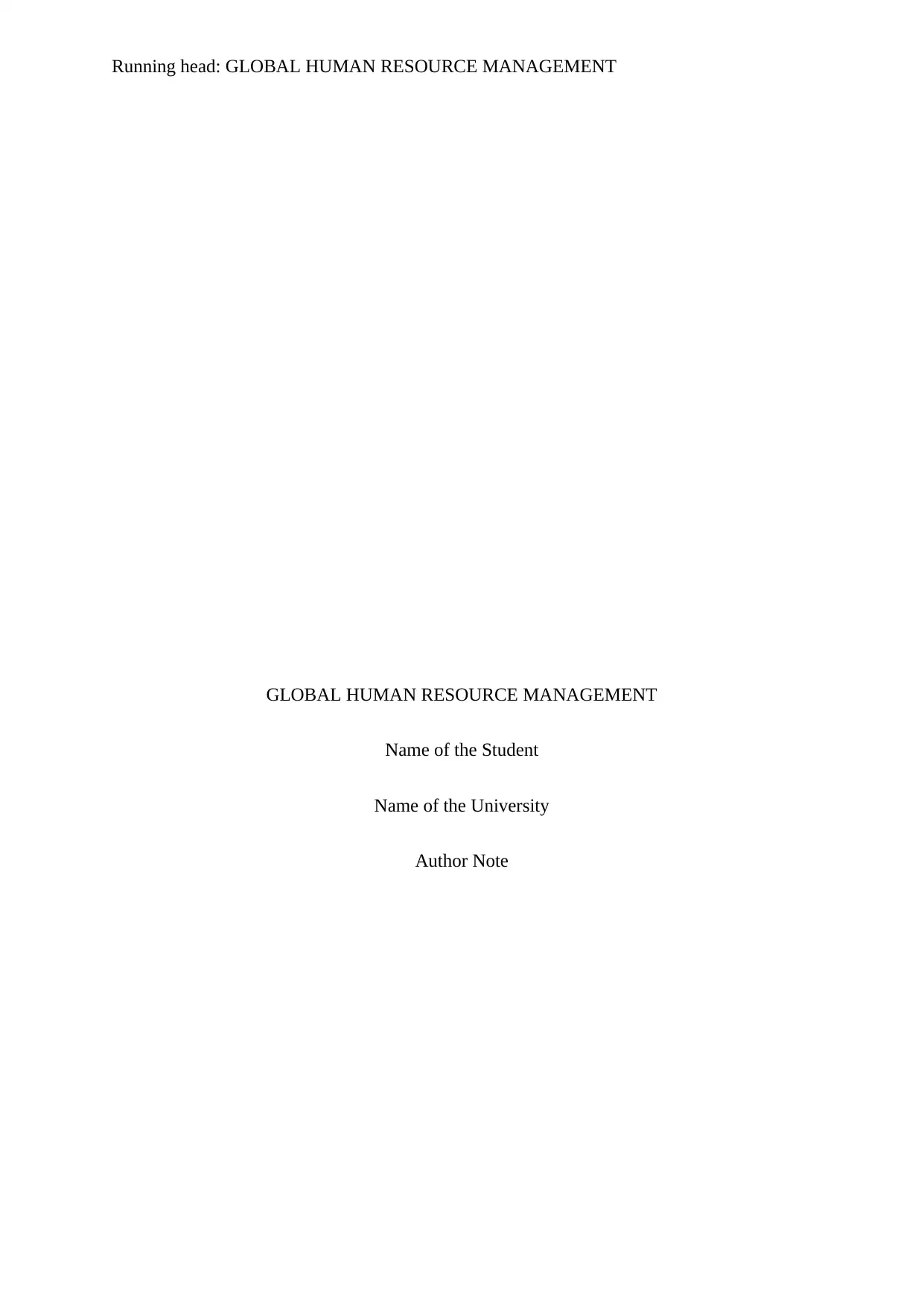
Running head: GLOBAL HUMAN RESOURCE MANAGEMENT
GLOBAL HUMAN RESOURCE MANAGEMENT
Name of the Student
Name of the University
Author Note
GLOBAL HUMAN RESOURCE MANAGEMENT
Name of the Student
Name of the University
Author Note
Paraphrase This Document
Need a fresh take? Get an instant paraphrase of this document with our AI Paraphraser
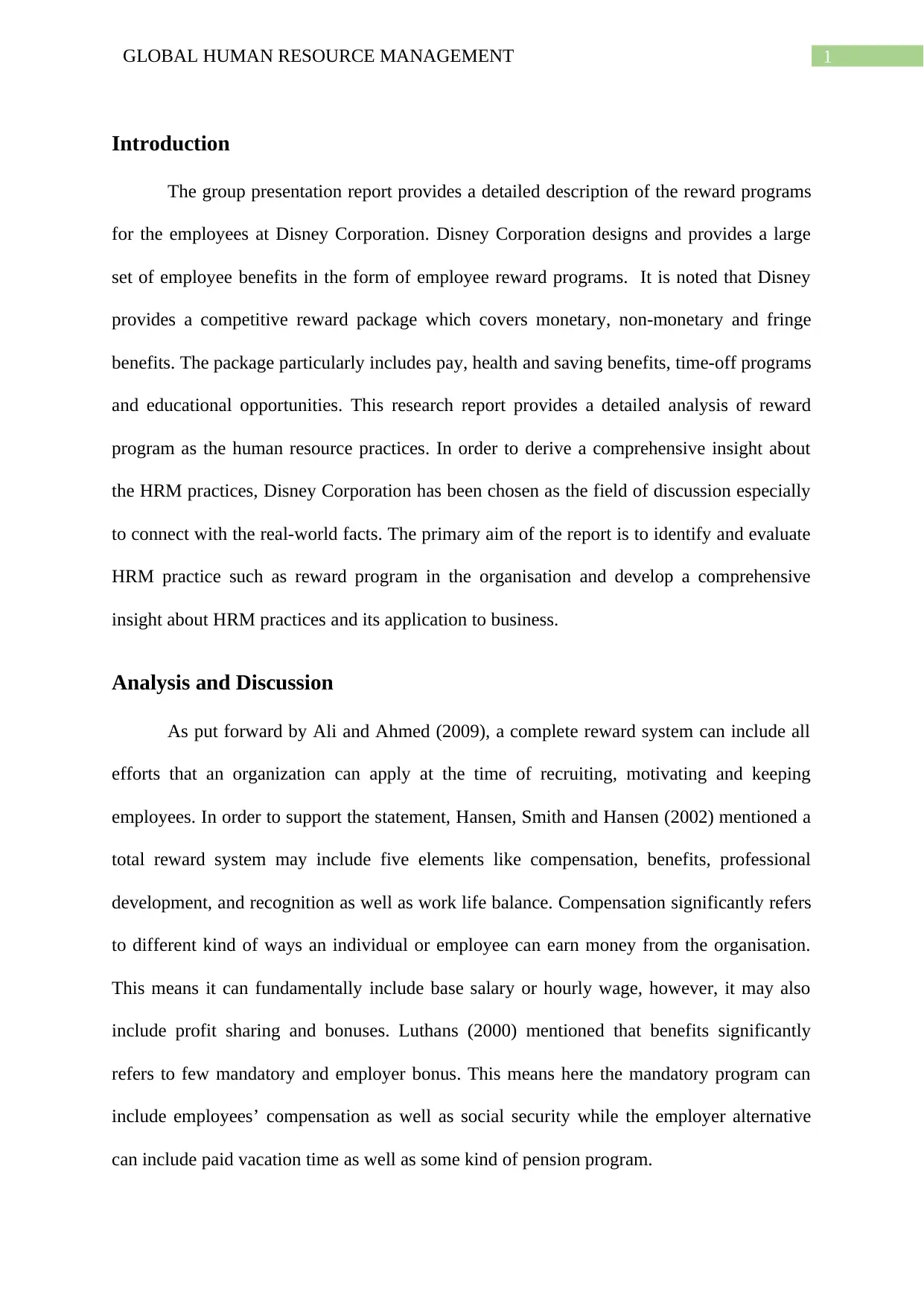
1GLOBAL HUMAN RESOURCE MANAGEMENT
Introduction
The group presentation report provides a detailed description of the reward programs
for the employees at Disney Corporation. Disney Corporation designs and provides a large
set of employee benefits in the form of employee reward programs. It is noted that Disney
provides a competitive reward package which covers monetary, non-monetary and fringe
benefits. The package particularly includes pay, health and saving benefits, time-off programs
and educational opportunities. This research report provides a detailed analysis of reward
program as the human resource practices. In order to derive a comprehensive insight about
the HRM practices, Disney Corporation has been chosen as the field of discussion especially
to connect with the real-world facts. The primary aim of the report is to identify and evaluate
HRM practice such as reward program in the organisation and develop a comprehensive
insight about HRM practices and its application to business.
Analysis and Discussion
As put forward by Ali and Ahmed (2009), a complete reward system can include all
efforts that an organization can apply at the time of recruiting, motivating and keeping
employees. In order to support the statement, Hansen, Smith and Hansen (2002) mentioned a
total reward system may include five elements like compensation, benefits, professional
development, and recognition as well as work life balance. Compensation significantly refers
to different kind of ways an individual or employee can earn money from the organisation.
This means it can fundamentally include base salary or hourly wage, however, it may also
include profit sharing and bonuses. Luthans (2000) mentioned that benefits significantly
refers to few mandatory and employer bonus. This means here the mandatory program can
include employees’ compensation as well as social security while the employer alternative
can include paid vacation time as well as some kind of pension program.
Introduction
The group presentation report provides a detailed description of the reward programs
for the employees at Disney Corporation. Disney Corporation designs and provides a large
set of employee benefits in the form of employee reward programs. It is noted that Disney
provides a competitive reward package which covers monetary, non-monetary and fringe
benefits. The package particularly includes pay, health and saving benefits, time-off programs
and educational opportunities. This research report provides a detailed analysis of reward
program as the human resource practices. In order to derive a comprehensive insight about
the HRM practices, Disney Corporation has been chosen as the field of discussion especially
to connect with the real-world facts. The primary aim of the report is to identify and evaluate
HRM practice such as reward program in the organisation and develop a comprehensive
insight about HRM practices and its application to business.
Analysis and Discussion
As put forward by Ali and Ahmed (2009), a complete reward system can include all
efforts that an organization can apply at the time of recruiting, motivating and keeping
employees. In order to support the statement, Hansen, Smith and Hansen (2002) mentioned a
total reward system may include five elements like compensation, benefits, professional
development, and recognition as well as work life balance. Compensation significantly refers
to different kind of ways an individual or employee can earn money from the organisation.
This means it can fundamentally include base salary or hourly wage, however, it may also
include profit sharing and bonuses. Luthans (2000) mentioned that benefits significantly
refers to few mandatory and employer bonus. This means here the mandatory program can
include employees’ compensation as well as social security while the employer alternative
can include paid vacation time as well as some kind of pension program.
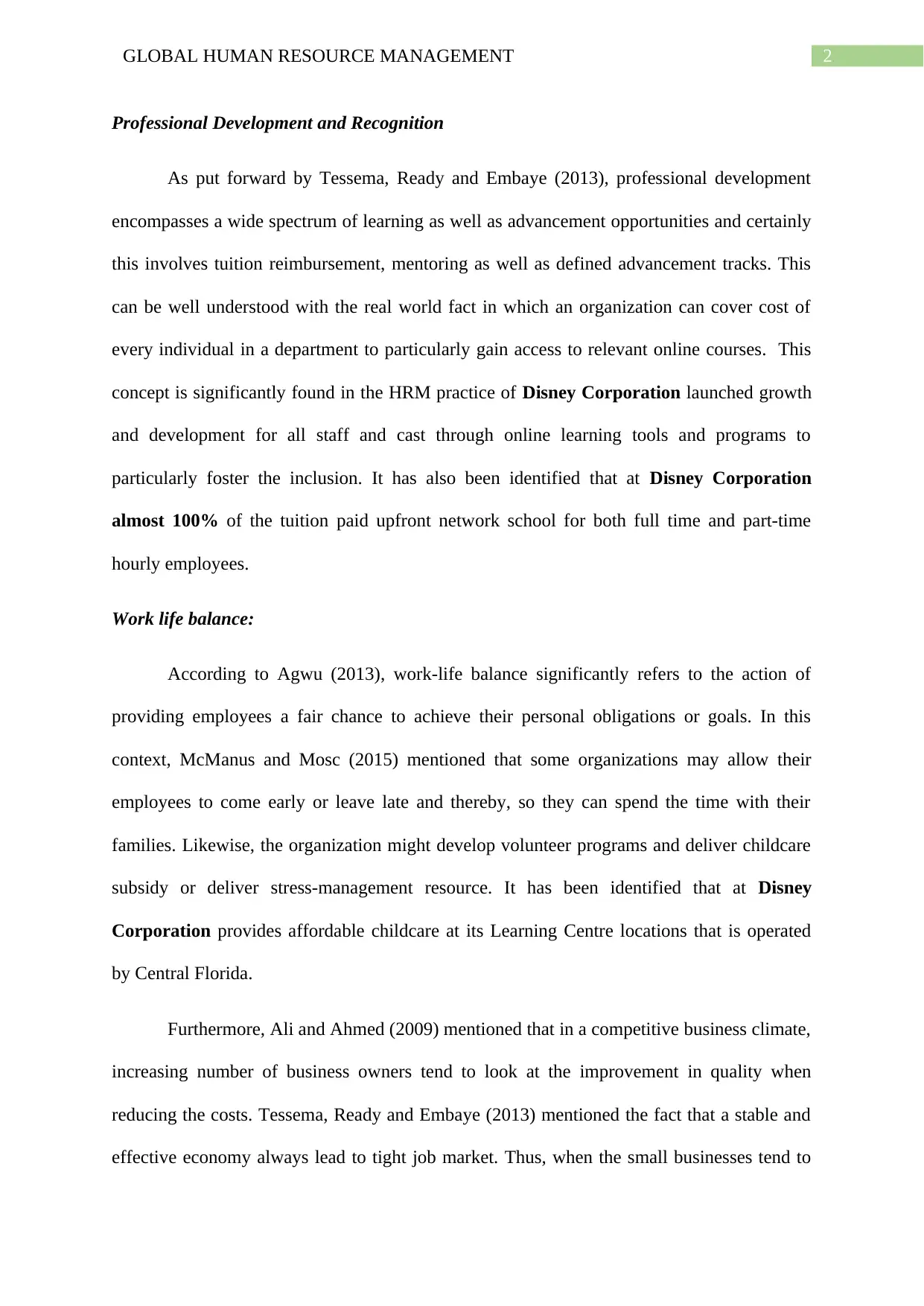
2GLOBAL HUMAN RESOURCE MANAGEMENT
Professional Development and Recognition
As put forward by Tessema, Ready and Embaye (2013), professional development
encompasses a wide spectrum of learning as well as advancement opportunities and certainly
this involves tuition reimbursement, mentoring as well as defined advancement tracks. This
can be well understood with the real world fact in which an organization can cover cost of
every individual in a department to particularly gain access to relevant online courses. This
concept is significantly found in the HRM practice of Disney Corporation launched growth
and development for all staff and cast through online learning tools and programs to
particularly foster the inclusion. It has also been identified that at Disney Corporation
almost 100% of the tuition paid upfront network school for both full time and part-time
hourly employees.
Work life balance:
According to Agwu (2013), work-life balance significantly refers to the action of
providing employees a fair chance to achieve their personal obligations or goals. In this
context, McManus and Mosc (2015) mentioned that some organizations may allow their
employees to come early or leave late and thereby, so they can spend the time with their
families. Likewise, the organization might develop volunteer programs and deliver childcare
subsidy or deliver stress-management resource. It has been identified that at Disney
Corporation provides affordable childcare at its Learning Centre locations that is operated
by Central Florida.
Furthermore, Ali and Ahmed (2009) mentioned that in a competitive business climate,
increasing number of business owners tend to look at the improvement in quality when
reducing the costs. Tessema, Ready and Embaye (2013) mentioned the fact that a stable and
effective economy always lead to tight job market. Thus, when the small businesses tend to
Professional Development and Recognition
As put forward by Tessema, Ready and Embaye (2013), professional development
encompasses a wide spectrum of learning as well as advancement opportunities and certainly
this involves tuition reimbursement, mentoring as well as defined advancement tracks. This
can be well understood with the real world fact in which an organization can cover cost of
every individual in a department to particularly gain access to relevant online courses. This
concept is significantly found in the HRM practice of Disney Corporation launched growth
and development for all staff and cast through online learning tools and programs to
particularly foster the inclusion. It has also been identified that at Disney Corporation
almost 100% of the tuition paid upfront network school for both full time and part-time
hourly employees.
Work life balance:
According to Agwu (2013), work-life balance significantly refers to the action of
providing employees a fair chance to achieve their personal obligations or goals. In this
context, McManus and Mosc (2015) mentioned that some organizations may allow their
employees to come early or leave late and thereby, so they can spend the time with their
families. Likewise, the organization might develop volunteer programs and deliver childcare
subsidy or deliver stress-management resource. It has been identified that at Disney
Corporation provides affordable childcare at its Learning Centre locations that is operated
by Central Florida.
Furthermore, Ali and Ahmed (2009) mentioned that in a competitive business climate,
increasing number of business owners tend to look at the improvement in quality when
reducing the costs. Tessema, Ready and Embaye (2013) mentioned the fact that a stable and
effective economy always lead to tight job market. Thus, when the small businesses tend to
⊘ This is a preview!⊘
Do you want full access?
Subscribe today to unlock all pages.

Trusted by 1+ million students worldwide
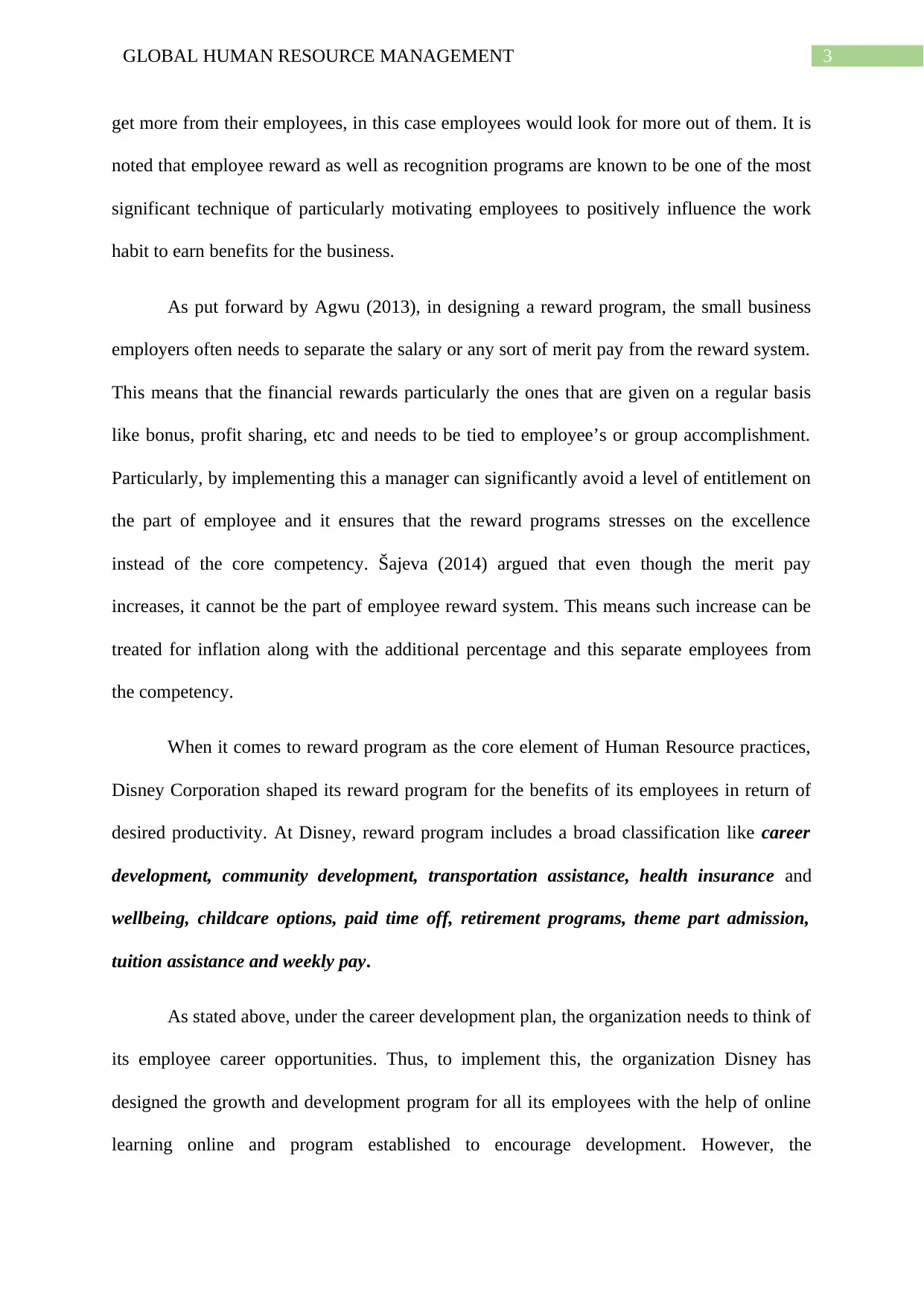
3GLOBAL HUMAN RESOURCE MANAGEMENT
get more from their employees, in this case employees would look for more out of them. It is
noted that employee reward as well as recognition programs are known to be one of the most
significant technique of particularly motivating employees to positively influence the work
habit to earn benefits for the business.
As put forward by Agwu (2013), in designing a reward program, the small business
employers often needs to separate the salary or any sort of merit pay from the reward system.
This means that the financial rewards particularly the ones that are given on a regular basis
like bonus, profit sharing, etc and needs to be tied to employee’s or group accomplishment.
Particularly, by implementing this a manager can significantly avoid a level of entitlement on
the part of employee and it ensures that the reward programs stresses on the excellence
instead of the core competency. Šajeva (2014) argued that even though the merit pay
increases, it cannot be the part of employee reward system. This means such increase can be
treated for inflation along with the additional percentage and this separate employees from
the competency.
When it comes to reward program as the core element of Human Resource practices,
Disney Corporation shaped its reward program for the benefits of its employees in return of
desired productivity. At Disney, reward program includes a broad classification like career
development, community development, transportation assistance, health insurance and
wellbeing, childcare options, paid time off, retirement programs, theme part admission,
tuition assistance and weekly pay.
As stated above, under the career development plan, the organization needs to think of
its employee career opportunities. Thus, to implement this, the organization Disney has
designed the growth and development program for all its employees with the help of online
learning online and program established to encourage development. However, the
get more from their employees, in this case employees would look for more out of them. It is
noted that employee reward as well as recognition programs are known to be one of the most
significant technique of particularly motivating employees to positively influence the work
habit to earn benefits for the business.
As put forward by Agwu (2013), in designing a reward program, the small business
employers often needs to separate the salary or any sort of merit pay from the reward system.
This means that the financial rewards particularly the ones that are given on a regular basis
like bonus, profit sharing, etc and needs to be tied to employee’s or group accomplishment.
Particularly, by implementing this a manager can significantly avoid a level of entitlement on
the part of employee and it ensures that the reward programs stresses on the excellence
instead of the core competency. Šajeva (2014) argued that even though the merit pay
increases, it cannot be the part of employee reward system. This means such increase can be
treated for inflation along with the additional percentage and this separate employees from
the competency.
When it comes to reward program as the core element of Human Resource practices,
Disney Corporation shaped its reward program for the benefits of its employees in return of
desired productivity. At Disney, reward program includes a broad classification like career
development, community development, transportation assistance, health insurance and
wellbeing, childcare options, paid time off, retirement programs, theme part admission,
tuition assistance and weekly pay.
As stated above, under the career development plan, the organization needs to think of
its employee career opportunities. Thus, to implement this, the organization Disney has
designed the growth and development program for all its employees with the help of online
learning online and program established to encourage development. However, the
Paraphrase This Document
Need a fresh take? Get an instant paraphrase of this document with our AI Paraphraser
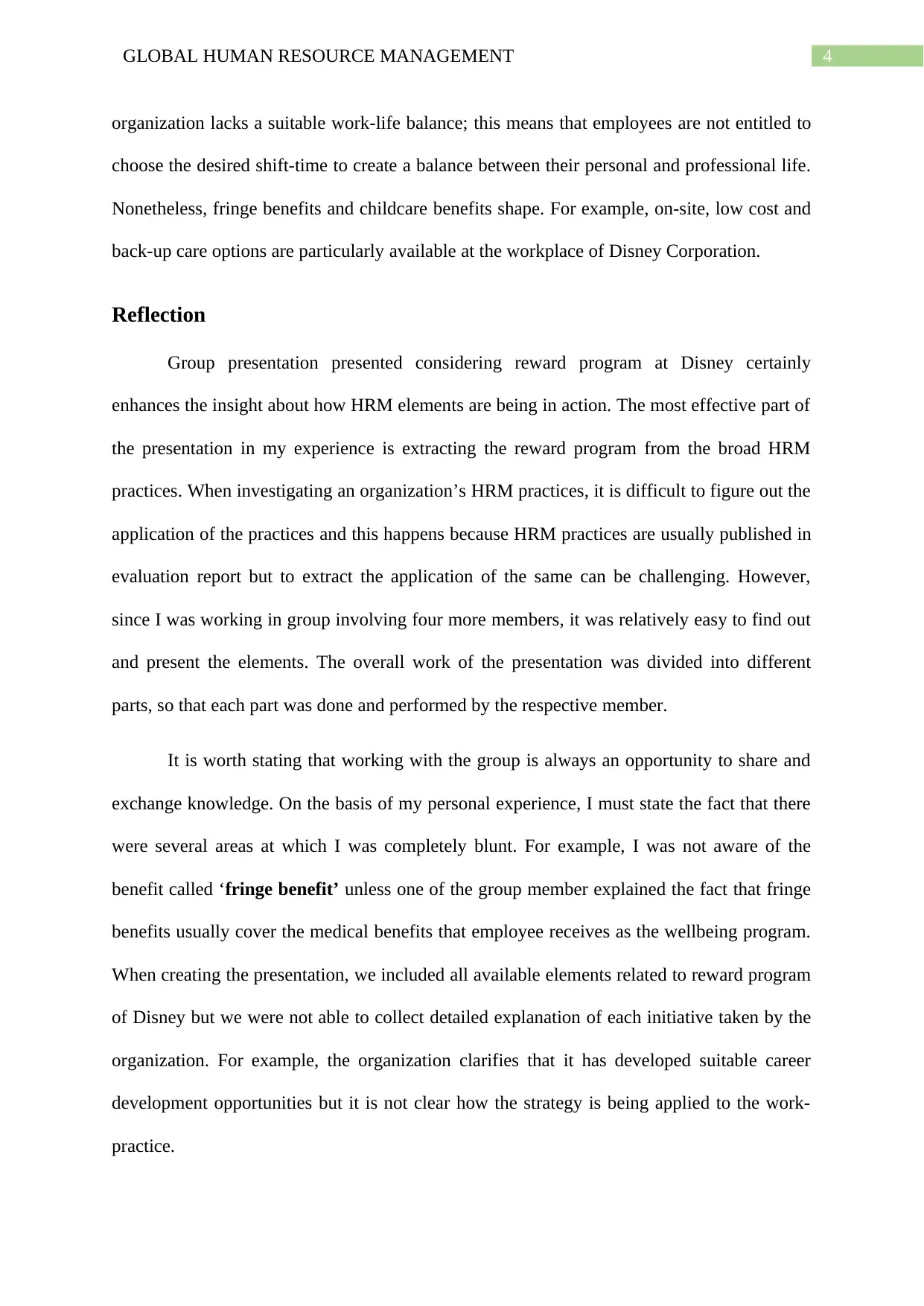
4GLOBAL HUMAN RESOURCE MANAGEMENT
organization lacks a suitable work-life balance; this means that employees are not entitled to
choose the desired shift-time to create a balance between their personal and professional life.
Nonetheless, fringe benefits and childcare benefits shape. For example, on-site, low cost and
back-up care options are particularly available at the workplace of Disney Corporation.
Reflection
Group presentation presented considering reward program at Disney certainly
enhances the insight about how HRM elements are being in action. The most effective part of
the presentation in my experience is extracting the reward program from the broad HRM
practices. When investigating an organization’s HRM practices, it is difficult to figure out the
application of the practices and this happens because HRM practices are usually published in
evaluation report but to extract the application of the same can be challenging. However,
since I was working in group involving four more members, it was relatively easy to find out
and present the elements. The overall work of the presentation was divided into different
parts, so that each part was done and performed by the respective member.
It is worth stating that working with the group is always an opportunity to share and
exchange knowledge. On the basis of my personal experience, I must state the fact that there
were several areas at which I was completely blunt. For example, I was not aware of the
benefit called ‘fringe benefit’ unless one of the group member explained the fact that fringe
benefits usually cover the medical benefits that employee receives as the wellbeing program.
When creating the presentation, we included all available elements related to reward program
of Disney but we were not able to collect detailed explanation of each initiative taken by the
organization. For example, the organization clarifies that it has developed suitable career
development opportunities but it is not clear how the strategy is being applied to the work-
practice.
organization lacks a suitable work-life balance; this means that employees are not entitled to
choose the desired shift-time to create a balance between their personal and professional life.
Nonetheless, fringe benefits and childcare benefits shape. For example, on-site, low cost and
back-up care options are particularly available at the workplace of Disney Corporation.
Reflection
Group presentation presented considering reward program at Disney certainly
enhances the insight about how HRM elements are being in action. The most effective part of
the presentation in my experience is extracting the reward program from the broad HRM
practices. When investigating an organization’s HRM practices, it is difficult to figure out the
application of the practices and this happens because HRM practices are usually published in
evaluation report but to extract the application of the same can be challenging. However,
since I was working in group involving four more members, it was relatively easy to find out
and present the elements. The overall work of the presentation was divided into different
parts, so that each part was done and performed by the respective member.
It is worth stating that working with the group is always an opportunity to share and
exchange knowledge. On the basis of my personal experience, I must state the fact that there
were several areas at which I was completely blunt. For example, I was not aware of the
benefit called ‘fringe benefit’ unless one of the group member explained the fact that fringe
benefits usually cover the medical benefits that employee receives as the wellbeing program.
When creating the presentation, we included all available elements related to reward program
of Disney but we were not able to collect detailed explanation of each initiative taken by the
organization. For example, the organization clarifies that it has developed suitable career
development opportunities but it is not clear how the strategy is being applied to the work-
practice.
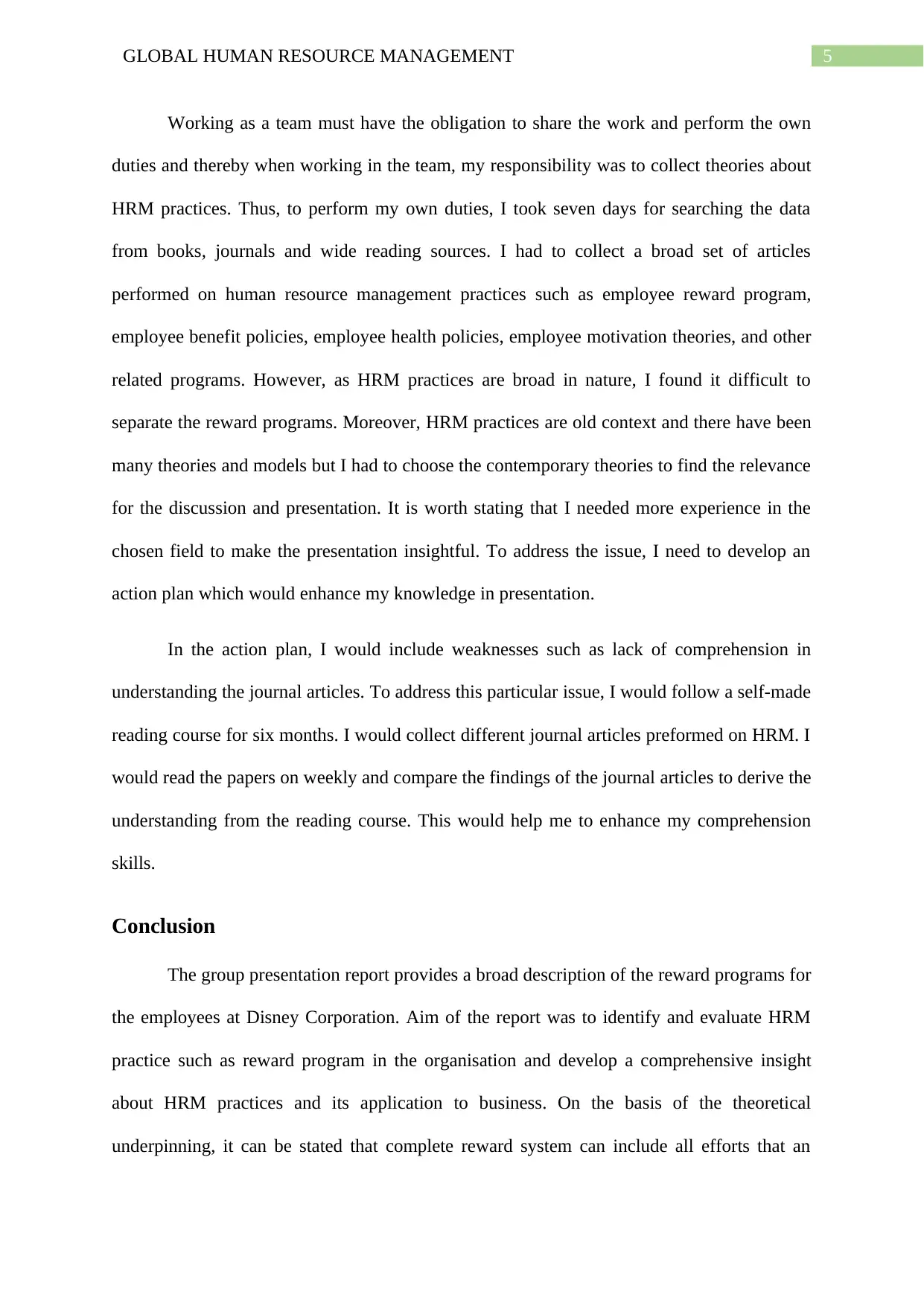
5GLOBAL HUMAN RESOURCE MANAGEMENT
Working as a team must have the obligation to share the work and perform the own
duties and thereby when working in the team, my responsibility was to collect theories about
HRM practices. Thus, to perform my own duties, I took seven days for searching the data
from books, journals and wide reading sources. I had to collect a broad set of articles
performed on human resource management practices such as employee reward program,
employee benefit policies, employee health policies, employee motivation theories, and other
related programs. However, as HRM practices are broad in nature, I found it difficult to
separate the reward programs. Moreover, HRM practices are old context and there have been
many theories and models but I had to choose the contemporary theories to find the relevance
for the discussion and presentation. It is worth stating that I needed more experience in the
chosen field to make the presentation insightful. To address the issue, I need to develop an
action plan which would enhance my knowledge in presentation.
In the action plan, I would include weaknesses such as lack of comprehension in
understanding the journal articles. To address this particular issue, I would follow a self-made
reading course for six months. I would collect different journal articles preformed on HRM. I
would read the papers on weekly and compare the findings of the journal articles to derive the
understanding from the reading course. This would help me to enhance my comprehension
skills.
Conclusion
The group presentation report provides a broad description of the reward programs for
the employees at Disney Corporation. Aim of the report was to identify and evaluate HRM
practice such as reward program in the organisation and develop a comprehensive insight
about HRM practices and its application to business. On the basis of the theoretical
underpinning, it can be stated that complete reward system can include all efforts that an
Working as a team must have the obligation to share the work and perform the own
duties and thereby when working in the team, my responsibility was to collect theories about
HRM practices. Thus, to perform my own duties, I took seven days for searching the data
from books, journals and wide reading sources. I had to collect a broad set of articles
performed on human resource management practices such as employee reward program,
employee benefit policies, employee health policies, employee motivation theories, and other
related programs. However, as HRM practices are broad in nature, I found it difficult to
separate the reward programs. Moreover, HRM practices are old context and there have been
many theories and models but I had to choose the contemporary theories to find the relevance
for the discussion and presentation. It is worth stating that I needed more experience in the
chosen field to make the presentation insightful. To address the issue, I need to develop an
action plan which would enhance my knowledge in presentation.
In the action plan, I would include weaknesses such as lack of comprehension in
understanding the journal articles. To address this particular issue, I would follow a self-made
reading course for six months. I would collect different journal articles preformed on HRM. I
would read the papers on weekly and compare the findings of the journal articles to derive the
understanding from the reading course. This would help me to enhance my comprehension
skills.
Conclusion
The group presentation report provides a broad description of the reward programs for
the employees at Disney Corporation. Aim of the report was to identify and evaluate HRM
practice such as reward program in the organisation and develop a comprehensive insight
about HRM practices and its application to business. On the basis of the theoretical
underpinning, it can be stated that complete reward system can include all efforts that an
⊘ This is a preview!⊘
Do you want full access?
Subscribe today to unlock all pages.

Trusted by 1+ million students worldwide
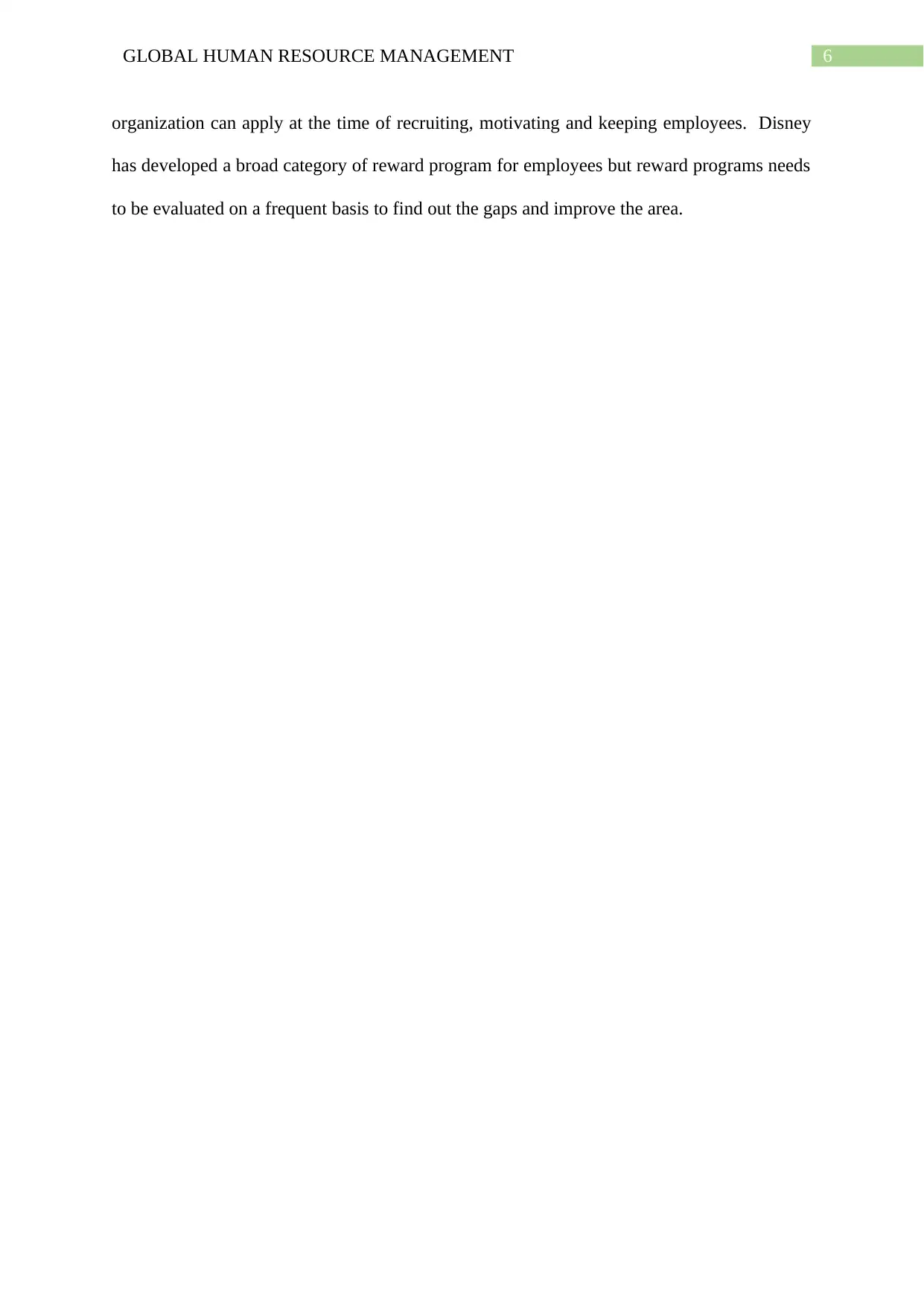
6GLOBAL HUMAN RESOURCE MANAGEMENT
organization can apply at the time of recruiting, motivating and keeping employees. Disney
has developed a broad category of reward program for employees but reward programs needs
to be evaluated on a frequent basis to find out the gaps and improve the area.
organization can apply at the time of recruiting, motivating and keeping employees. Disney
has developed a broad category of reward program for employees but reward programs needs
to be evaluated on a frequent basis to find out the gaps and improve the area.
Paraphrase This Document
Need a fresh take? Get an instant paraphrase of this document with our AI Paraphraser
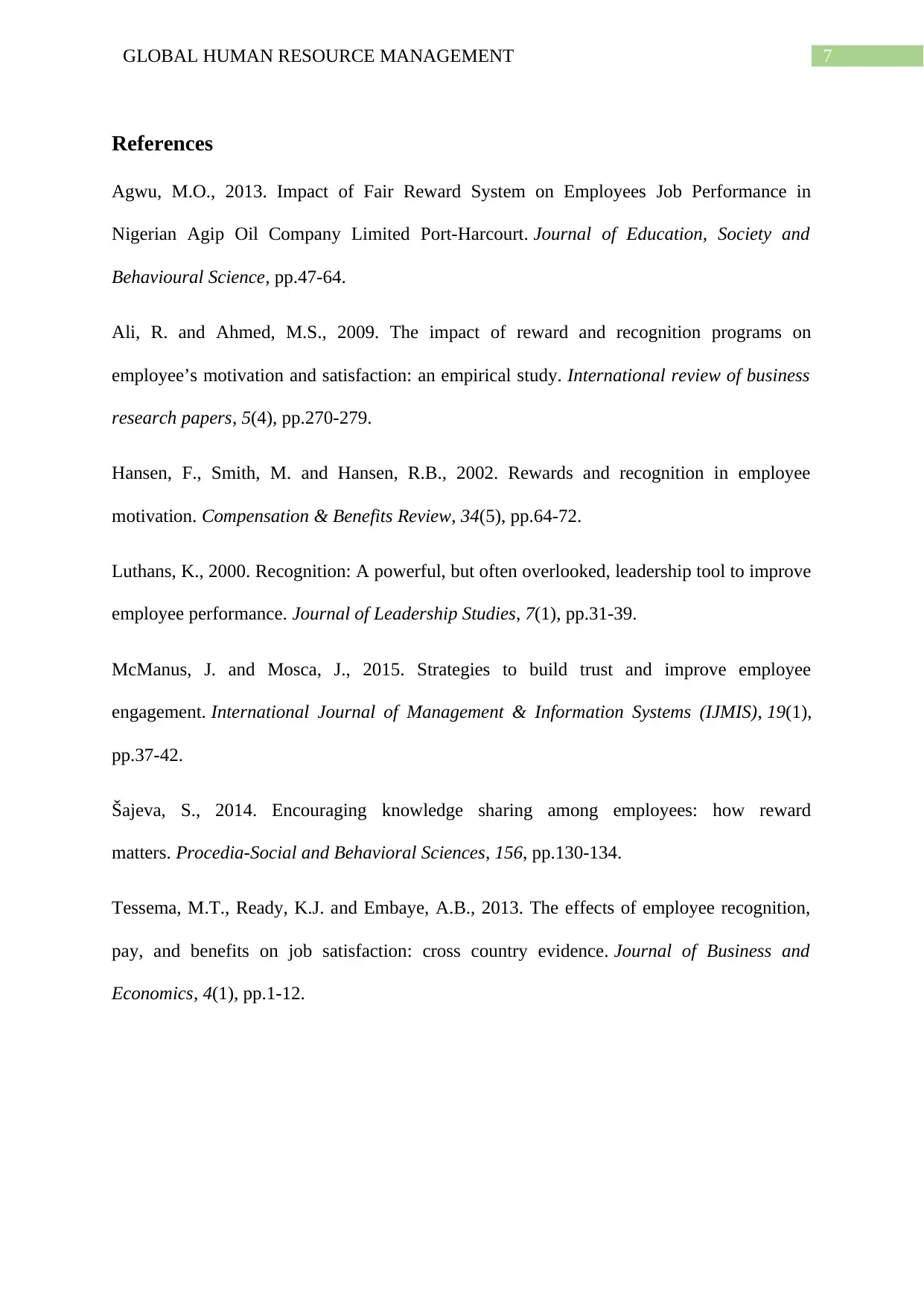
7GLOBAL HUMAN RESOURCE MANAGEMENT
References
Agwu, M.O., 2013. Impact of Fair Reward System on Employees Job Performance in
Nigerian Agip Oil Company Limited Port-Harcourt. Journal of Education, Society and
Behavioural Science, pp.47-64.
Ali, R. and Ahmed, M.S., 2009. The impact of reward and recognition programs on
employee’s motivation and satisfaction: an empirical study. International review of business
research papers, 5(4), pp.270-279.
Hansen, F., Smith, M. and Hansen, R.B., 2002. Rewards and recognition in employee
motivation. Compensation & Benefits Review, 34(5), pp.64-72.
Luthans, K., 2000. Recognition: A powerful, but often overlooked, leadership tool to improve
employee performance. Journal of Leadership Studies, 7(1), pp.31-39.
McManus, J. and Mosca, J., 2015. Strategies to build trust and improve employee
engagement. International Journal of Management & Information Systems (IJMIS), 19(1),
pp.37-42.
Šajeva, S., 2014. Encouraging knowledge sharing among employees: how reward
matters. Procedia-Social and Behavioral Sciences, 156, pp.130-134.
Tessema, M.T., Ready, K.J. and Embaye, A.B., 2013. The effects of employee recognition,
pay, and benefits on job satisfaction: cross country evidence. Journal of Business and
Economics, 4(1), pp.1-12.
References
Agwu, M.O., 2013. Impact of Fair Reward System on Employees Job Performance in
Nigerian Agip Oil Company Limited Port-Harcourt. Journal of Education, Society and
Behavioural Science, pp.47-64.
Ali, R. and Ahmed, M.S., 2009. The impact of reward and recognition programs on
employee’s motivation and satisfaction: an empirical study. International review of business
research papers, 5(4), pp.270-279.
Hansen, F., Smith, M. and Hansen, R.B., 2002. Rewards and recognition in employee
motivation. Compensation & Benefits Review, 34(5), pp.64-72.
Luthans, K., 2000. Recognition: A powerful, but often overlooked, leadership tool to improve
employee performance. Journal of Leadership Studies, 7(1), pp.31-39.
McManus, J. and Mosca, J., 2015. Strategies to build trust and improve employee
engagement. International Journal of Management & Information Systems (IJMIS), 19(1),
pp.37-42.
Šajeva, S., 2014. Encouraging knowledge sharing among employees: how reward
matters. Procedia-Social and Behavioral Sciences, 156, pp.130-134.
Tessema, M.T., Ready, K.J. and Embaye, A.B., 2013. The effects of employee recognition,
pay, and benefits on job satisfaction: cross country evidence. Journal of Business and
Economics, 4(1), pp.1-12.
1 out of 8
Related Documents
Your All-in-One AI-Powered Toolkit for Academic Success.
+13062052269
info@desklib.com
Available 24*7 on WhatsApp / Email
![[object Object]](/_next/static/media/star-bottom.7253800d.svg)
Unlock your academic potential
Copyright © 2020–2025 A2Z Services. All Rights Reserved. Developed and managed by ZUCOL.





